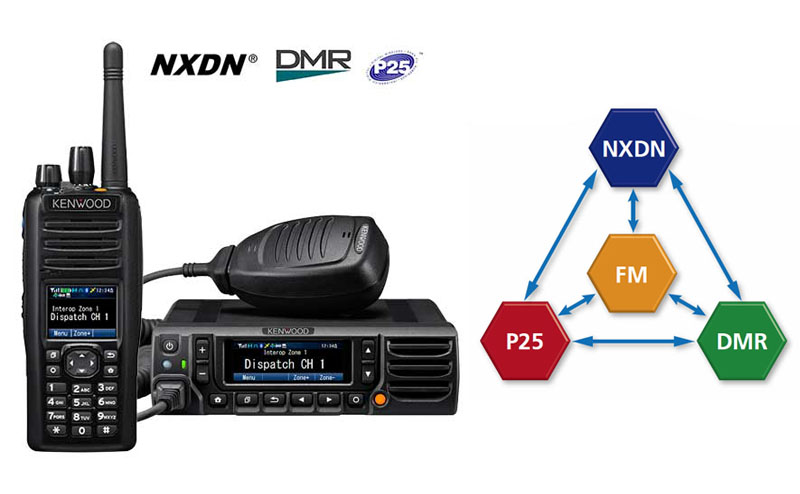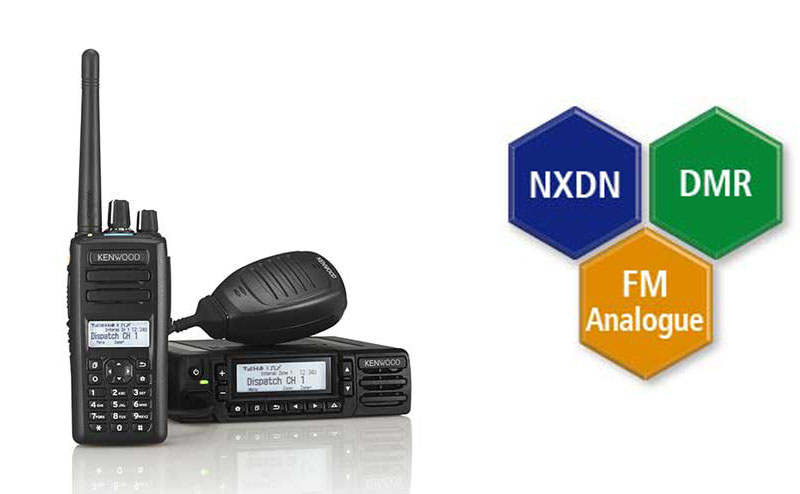Guide to KENWOOD Multi-Protocol Communications
What do we mean by multi-protocol radio and how does it future-proof your two-way radio communications?
MULTI-PROTOCOL OPERATION
As the term suggests, multi-protocol radios can operate in more than one protocol.
However, to achieve that is not as simple as it may sound, as typically digital two-way radios operate in FM Analogue plus one digital air access protocol; usually, either FM plus NXDN, or FM plus P25 or FM plus DMR as the three most common digital air interfaces. That’s because the FDMA (Frequency Division Multiple Access) method employed in NXDN, dPMR and P25 Phase 1 and the TDMA (Time Division Multiple Access) method employed in the DMR protocol are distinct and incompatible with each other.
The other issue is that most radio communication equipment manufacturers focus on developing products to operate on either the FDMA or TDMA air access protocol; but Kenwood have changed all that and at last, end users have a real choice. That’s because, as a protocol-neutral manufacturer of two-way radio equipment offering FDMA, TDMA and P25 solutions, Kenwood could take a different approach and its R&D team were given the challenge to develop a ‘one-radio, multi-protocol’ solution.
In 2015 after almost 25 years in the Private Mobile Radio market (PMR), Kenwood launched its first multi-protocol radio in the NX-5000 Series.
NX-5000 Series. A multi-protocol revolution in two-way radio.
The result was the NX-5000 Series of hand-portable walkie talkies and in-vehicle mobile radios; a revolution in two-way radio in that they could combine FM Analogue and two different digital air interface protocols, FDMA (Frequency Division Multiple Access) and TDMA (Time Division Multiple Access) in one radio.
NX-5000 Series radios can be configured to simultaneously support the following combinations of access protocols:

FM + DMR (Tier II) + NXDN
FM + NXDN (Gen1 and 2) + P25 (Phase 1 & 2)
FM + DMR (Tier II) + P25 (Phase 1 & 2)
The NX-5000 Series was developed specifically to meet the needs of mission critical users, for example, first responder emergency services attending a major incident or teams engaged in search and rescue or providing aid following natural disasters where different radio protocols may be in use by different agencies. As you would expect, the radios are equipped with a wealth of advanced user safety and security features as standard along with programmable functions that can be tailored to meet the specific operational requirements.
But the engineers at Kenwood weren’t satisfied.
They wanted to develop a multi-protocol radio that would meet the needs of the much broader audience of private and public sector users, from retail to hospitality, public services, facilities management, crowd control and security to general commercial users and manufacturing industries.
The goal was to deliver a feature-rich radio with intuitive operation that would be ideally suited to users migrating from analogue to digital operation but undecided on which digital protocol would best suit their operations today and into the future or those currently using either NXDN or DMR protocols looking for the flexibility to easily switch from one to the other at a later date.
Naturally, the solution would also have to offer the user-safety and convenience features required for a wide variety of user applications and as important, be made available at a highly competitive price.
In 2017, they achieved their goal in the NX-3000 Series. A highly competitive, future-proofed, multi-protocol radio communications solution
The ability to have NX-3000 hand-portable and mobile radios programmed for either FM + DMR or FM + NXDN operation allows users to significantly reduce the risk of making a costly error when selecting a digital protocol that offers both the flexibility and scalability to meet their needs, which may change over time.
NX-3000 Series radios can be configured to simultaneously support FM Analogue + one digital access protocol, but offers the flexibility for users to switch between either of the two digital protocols easily and cost effectively:
FM + DMR (Tier II) (6.25 kHz equivalent TDMA digital)
FM + NXDN (Gen1 and 2) (Native 6.25 kHz FDMA digital)
What’s the difference between the FDMA and TDMA protocols?
Both protocols are recognised, have been widely adopted and proven worldwide and are supported by a variety of application solutions from world-class developers. The NXDN Air Interface (FDMA) is accepted by the International Telecommunication Union Radiocommunications Sector (ITU-R) while DMR (TDMA) is a European Telecommunications Standards Institute (ETSI) standard.
Each offers specific features and benefits with the choice between the two protocols typically made on the basis of suitability for a particular radio communications requirement, for instance:
Volume of voice and/or voice and data transmissions
► Number of users on the radio network
► Number of discrete channels/individual users groups to be accomodated
► Operating environment
► nfrastructure required
► Cost of infrastructure
► Ease of implementation
► Ease of management of devices on the network
► Equipment features
► Cost of equipment
► Availability of applications for requirement
► Inherent flexibility
► Inherent scalability
What’s the difference between NXDN and DMR protocols?

KAS-20 NEXEDGE® NXDNTM and DMR AVL and Dispatch Software Suite
To maximise the functionality and capability of the Multi-Protocol NX-5000 and NX-3000 Series, Kenwood has introduced the KAS-20 all-in-one Dispatch and AVL solution for NEXEDGE Gen2 Trunking, Trunk C, NXDN IP conventional and DMR IP conventional operation.
A significant development from the proven KAS-10 suite, KAS-20 AVL and Dispatch Software is compatible with KENWOOD digital radio systems and runs on Windows and Windows Server. It offers a cost-effective stand-alone solution or the basis to build a fully scalable, customised AVL and dispatch system and supports both NXDN and DMR digital protocols.
KAS-20 features a user-friendly Graphical UI and map displays for intuitive operation, the software enables seamless operations to control multiple subscriber units on the same network, employing either a client configuration or a server configuration with multiple clients while, by purchasing optional licenses, you can add value-added features in the future to meet your specific needs.
Conclusion
With the NX-5000 and NX-3000 Series radios, Kenwood has removed the major concerns users might have in migrating from analogue to digital two-way radio technology.
The ability to use the radios in automatic mixed modes means that any existing FM analogue radios can still be employed while digital migration takes place over time; but what makes the biggest difference is the ability to switch from one leading digital protocol to another should needs change making Kenwood Multi-Protocol operation the most economical, flexible and futureproof option.
► Click here for enquiry form